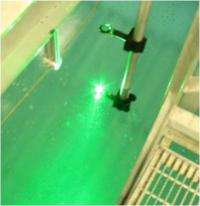Lasers generate underwater sound

Scientists at the Naval Research Laboratory (NRL) are developing a new technology for use in underwater acoustics. The new technology uses flashes of laser light to remotely create underwater sound. The new acoustic source has the potential to expand and improve both Naval and commercial underwater acoustic applications, including undersea communications, navigation, and acoustic imaging.
Dr. Ted Jones, a physicist in the Plasma Physics Division, is leading a team of researchers from the Plasma Physics, Acoustics, and Marine Geosciences Divisions in developing this acoustic source.
Efficient conversion of light into sound can be achieved by concentrating the light sufficiently to ionize a small amount of water, which then absorbs laser energy and superheats. The result is a small explosion of steam, which can generate a 220 decibel pulse of sound. Optical properties of water can be manipulated with very intense laser light to act like a focusing lens, allowing nonlinear self-focusing (NSF) to take place. In addition, the slightly different colors of the laser, which travel at different speeds in water due to group velocity dispersion (GVD), can be arranged so that the pulse also compresses in time as it travels through water, further concentrating the light. By using a combination of GVD and NSF, controlled underwater compression of optical pulses can be attained.
The driving laser pulse has the ability to travel through both air and water, so that a compact laser on either an underwater or airborne platform can be used for remote acoustic generation. Since GVD and NSF effects are much stronger in water than air, a properly tailored laser has the ability to travel many hundreds of meters through air, remaining relatively unchanged, then quickly compress upon entry into the water. Atmospheric laser propagation is useful for applications where airborne lasers produce underwater acoustic signals without any required hardware in the water, such as undersea communications from aircraft.
Also, commercially available, high-repetition-rate pulsed lasers, steered by a rapidly movable mirror, can generate arbitrary arrays of phased acoustic sources. On a compact underwater platform with an acoustic receiver, such a setup can rapidly generate oblique-angle acoustic scattering data, for imaging and identifying underwater objects. This would be a significant addition to traditional direct backscattering acoustic data.
Source: Naval Research Laboratory (news : web)


















